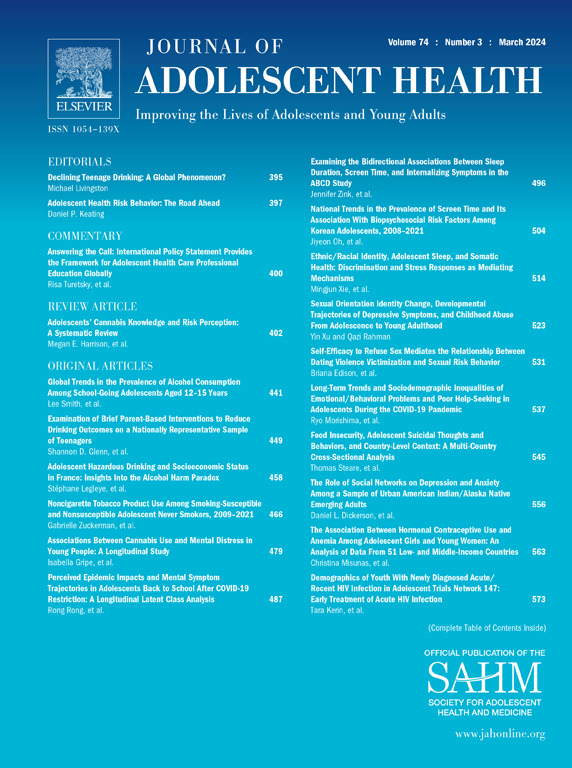Experiences of Pregnant and Parenting Adolescents and Young Women During COVID-19 Pandemic: A Mixed-Methods Study Among Girls and Women in Kenya
IF 5.5
2区 医学
Q1 PEDIATRICS
引用次数: 0
Abstract
Purpose
This study examines the experiences of pregnant/parenting adolescents and young women during the first two years of the coronavirus disease 2019 (COVID-19) pandemic.
Methods
This explanatory sequential mixed-methods study leverages quantitative data collected among a cohort of adolescents and young people aged 15–22 years in three Kenyan counties; Nairobi, Kisumu, and Kilifi at three time points (2020, 2021, 2022), and two rounds of qualitative interviews in the same settings conducted in 2020 and 2022.
Results
Among 2337 (2020), 1438 (2021), and 1669 (2022) respondents, pregnant/parenting adolescents and youth comprised 140 (6%), 101 (7%), and 83 (5%) individuals, respectively. Across the three time points, the experience of depressive symptoms was similar between pregnant/parenting adolescents and those not pregnant/parenting. Pregnancy and parenting was associated with twice the odds of skipping health services (adjusted odds ratio [aOR] 2.18, 95% confidence interval [CI] 1.43–3.35), in 2020, and 85% higher odds (aOR 1.85, 95% CI 1.14–3.02) in 2021, and 90% higher odds of skipping meals (aOR 1.90, 95% CI 1.19–3.03) in 2022. Qualitative findings indicated experiences of psychological distress, food insecurity, and inadequate access to health care services among pregnant/parenting young people during the pandemic.
Discussion
The pandemic increased pre-existing challenges associated with adolescent and young people's health, predisposing young pregnant/parenting women to greater adversity than their nonpregnant/parenting counterparts. Targeted and responsive approaches during emergencies and crises such as social protection, food security, and mental health programs for this group of vulnerable people are required and need to be integrated into disaster response plans.
在 COVID-19 大流行期间怀孕和为人父母的青少年和年轻妇女的经历:肯尼亚女孩和妇女的混合方法研究。
目的:本研究探讨了在冠状病毒病 2019 年(COVID-19)大流行的头两年中怀孕/育儿的青少年和年轻女性的经历:这项解释性顺序混合方法研究利用了在三个时间点(2020 年、2021 年和 2022 年)从肯尼亚三个县(内罗毕、基苏木和基利菲)的 15-22 岁青少年群体中收集的定量数据,以及 2020 年和 2022 年在相同环境中进行的两轮定性访谈:在 2337 名(2020 年)、1438 名(2021 年)和 1669 名(2022 年)受访者中,怀孕/育儿的青少年分别占 140 人(6%)、101 人(7%)和 83 人(5%)。在这三个时间点上,怀孕/育儿青少年与未怀孕/育儿青少年的抑郁症状经历相似。2020 年,怀孕和养育子女的青少年不接受医疗服务的几率是未怀孕和养育子女青少年的两倍(调整后的几率比 [aOR] 2.18,95% 置信区间 [CI] 1.43-3.35),2021 年的几率比未怀孕和养育子女青少年高 85%(aOR 1.85,95% 置信区间 [CI] 1.14-3.02),2022 年的几率比未怀孕和养育子女青少年高 90%(aOR 1.90,95% 置信区间 [CI] 1.19-3.03)。定性研究结果表明,在大流行期间,怀孕/为人父母的年轻人经历了心理困扰、食物无保障以及无法获得足够的医疗保健服务:大流行加剧了与青少年健康相关的原有挑战,使年轻孕妇/父母比非孕妇/父母面临更大的逆境。在紧急情况和危机期间,需要采取有针对性的应对措施,如针对这一弱势群体的社会保护、食品安全和心理健康计划,并将其纳入灾害应对计划。
本文章由计算机程序翻译,如有差异,请以英文原文为准。
求助全文
约1分钟内获得全文
求助全文
来源期刊

Journal of Adolescent Health
医学-公共卫生、环境卫生与职业卫生
CiteScore
10.40
自引率
3.90%
发文量
526
审稿时长
46 days
期刊介绍:
The Journal of Adolescent Health is a scientific publication dedicated to enhancing the health and well-being of adolescents and young adults. Our Journal covers a broad range of research topics, spanning from the basic biological and behavioral sciences to public health and policy. We welcome a variety of contributions, including original research papers, concise reports, literature reviews, clinical case reports, opinion pieces, and letters to the editor. We encourage professionals from diverse disciplines such as Anthropology, Education, Ethics, Global Health, Health Services Research, Law, Medicine, Mental and Behavioral Health, Nursing, Nutrition, Psychology, Public Health and Policy, Social Work, Sociology, and Youth Development to share their expertise and contribute to our mission of promoting adolescent health. Moreover, we value the voices of young individuals, family and community members, and healthcare professionals, and encourage them to submit poetry, personal narratives, images, and other creative works that provide unique insights into the experiences of adolescents and young adults. By combining scientific peer-reviewed research with creative expressions, our Journal aims to create a comprehensive understanding of the challenges and opportunities in adolescent and young adult health.
 求助内容:
求助内容: 应助结果提醒方式:
应助结果提醒方式:


